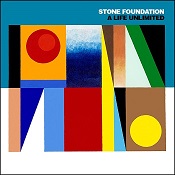 It’s always a good feeling when a band or artist you like starts to get a bit of recognition, particularly when you know they’ve put in the hard hours over a long period of time and they’re doing something that they believe in and they’re committed to body and soul. In 2014, things were finally starting to happen for Stone Foundation. After years of serious graft with no industry backing, playing support slots, organising their own tours and self-funding their releases, people started to take notice and they got a bit of radio exposure (Craig Charles helped a bit there). They did support tours with The Selecter and The Blow Monkeys and the album “To Find the Spirit” made a dent in the independent charts; even The Modfather was photographed holding a copy. So, where to next?
It’s always a good feeling when a band or artist you like starts to get a bit of recognition, particularly when you know they’ve put in the hard hours over a long period of time and they’re doing something that they believe in and they’re committed to body and soul. In 2014, things were finally starting to happen for Stone Foundation. After years of serious graft with no industry backing, playing support slots, organising their own tours and self-funding their releases, people started to take notice and they got a bit of radio exposure (Craig Charles helped a bit there). They did support tours with The Selecter and The Blow Monkeys and the album “To Find the Spirit” made a dent in the independent charts; even The Modfather was photographed holding a copy. So, where to next?
Well, the next album, “A Life Unlimited”, is out on August 7th, so that’s a pretty good place to start. It would have been so easy to stick with the style that made “To Find the Spirit” successful, but that’s not what these guys do; the new album was always going to move in a slightly different direction, particularly after a few of the personnel changes that are almost inevitable in a large group.
The opening song, “Beverley”, (the theme tune from Alexander Thomas’ short film of the same name) is a tantalising hint as to the slight change of direction. It could almost be a track from the previous album, apart from the congas (courtesy of new member Rob Newton), which infuse a little Latin spirit into the funky cocktail of horns, Hammond and wah-wah guitars. There’s a change of emphasis in the brass section as well; Gareth John filled the trumpet vacancy last year and Adam Stevens has come in on baritone sax to replace trombonist Spencer Hague while he takes a break, both joining long-standing tenor saxophonist Gary Rollins. It gives the brass section a more Stax/Atlantic feel with a greater focus on ensemble playing as opposed to solos. It’s a philosophy which applies to the band generally; Stone Foundation is about eight guys working together to create gorgeous grooves and it works because the egos are reined in and the band is more important than the individual.
The sumptuous ballad “Pushing Your Love”, with harmonies from The Four Perfections, wouldn’t have sounded out of place on the previous album, while “Something in the Light” takes a little step forward with the brass section, particularly Adam Stevens’ baritone lines, generating a Memphis Horns feel and the Q Strings adding a touch of velvet to the sting of brass. And that’s all before the Van Morrison-style breakdown with strings, tenor sax and backing vocals from The Four Perfections and Janet and Samantha Harris. Lovely stuff.
“The Turnaround” and “Learning the Hard Way” are real departures for the band. The horn fills have a New York/Cuban feel which weave around Neil Sheasby’s bubbling bass lines and Neil Jones’ guitar to create a sound which is much more New York fusion than small town soul; the kind of thing Southside Johnny and his brass section The New York Horns have been doing so well recently. They’re both irresistibly funky.
It’s the two centre pieces (or the last track on side one and the first on side two if you’re going for the vinyl) which give the clearest indication of the new influences on this album; there’s a bit of jazz in the mix. “Speak Your Piece” is a sprawling epic of a song which starts with handclaps, a piano motif (which is picked up later by the horns) and a five-note bass riff which runs through the song. Even as the song builds and layers are added, there’s always plenty of space in the mix; it never feels crowded as it builds up to a noisy chorus and drops back to piano and bass under the lead before building up again to big horn-driven finale. There’s even a one-note piano solo from Ian Arnold, and if that isn’t jazz, I don’t know what is. “The Night Teller” has a mid-tempo cool jazz feel evoking the cover artwork of Donald Fagen’s classic “The Nightfly” album and features a guest vocal by Graham Parker underpinned by some understated baritone sax. It’s all beautifully played and GP’s vocal works perfectly as a complement to the voice of Neil Jones. “These Life Stories” is a mid-tempo groove built around some laconic brass ensemble playing and delicate electric piano and it’s another example of the ‘less is more’ philosophy; you don’t need flash when a band can play this well together. Even the conga solo is politely restrained.
“A Love Uprising”, the album’s penultimate track, opens up like a 1990 house tune with a simple piano riff and Philip Ford’s four-to-floor kick drum but, within a few bars congas come in to soften the beat before seventies hi-hats and funk guitar, and then brass fills morph the piece into classic New York disco. And who’s that coming in just before two minutes with a rap? It’s Dr Robert from The Blow Monkeys making a guest appearance. Just to add to the Studio 54 ambience, you even get congas and disco whistles; it’s so authentic they knocked back Nile Rodgers when he tried to get in to the session. The closing track “Old Partners, New Dances” is an instrumental piece featuring Ian Arnold on piano and Gareth John on flugel horn, evoking the feel of a jazz club at four in the morning and it’s perfect way to bring the album down for a soft landing after the manic buzz of “A Love Uprising”.
Since the sessions for “A Life Unlimited”, the band has signed record deals in Japan (with P-Vine Records) and the USA (with Spectra Music Group); things definitely aren’t standing still at the moment and, with this album, they probably have the right set of songs to break through. What shines through every aspect of the album is quality; the songs are well-crafted, the arrangements are sensitive and varied and the performances are all superb. Even the artwork by Horace Panter (you are going to buy it on CD or vinyl, aren’t you?) is spot on. Maybe “A Life Unlimited” proves that, in a world where a Glastonbury headliner gets away with out-of-tune karaoke, there’s still room for music created with passion and talent.
“A Life Unlimited” is released on August 7/ 2015.
Ok, call me obsessive if you like but as well as listening to a lot of albums and going to as many gigs as I can, I also read the odd book or two about music and popular culture and many of those are worth sharing with anyone who checks out MusicRiot regularly. This list was difficult to pin down to five from the start, but it became even more difficult on Christmas Day when I was given a copy of the Donald Fagen memoir/tour diary/article compilation, “Eminent Hipsters”. So I guess that’s a pretty good place to start.
“Eminent Hipsters” – Donald Fagen
 Where do I start with Donald Fagen? With Walter Becker, he was half of one of my favourite 70s bands, Steely Dan and then went on to release the classic solo album, “The Nightfly” in 1982, followed (not too closely) by “The Kamakiriad” in 1993. You’ve probably guessed by now, I’m a bit of a fan. “Eminent Hipsters” is partly an explanation, through a series of articles, of the factors which influenced the Steely Dan sound (cool jazz, cop dramas and wise-ass comedians) and the Donald Fagen solo sound (science fiction and mid-century paranoia). If you love the music, you’ll be fascinated by these observations about its roots. The second part of this slim volume is devoted to Fagen’s diary from the 2012 “Dukes of September Rhythm Revue” tour which is, by turn, snarky, moving, insightful and downright hilarious.
Where do I start with Donald Fagen? With Walter Becker, he was half of one of my favourite 70s bands, Steely Dan and then went on to release the classic solo album, “The Nightfly” in 1982, followed (not too closely) by “The Kamakiriad” in 1993. You’ve probably guessed by now, I’m a bit of a fan. “Eminent Hipsters” is partly an explanation, through a series of articles, of the factors which influenced the Steely Dan sound (cool jazz, cop dramas and wise-ass comedians) and the Donald Fagen solo sound (science fiction and mid-century paranoia). If you love the music, you’ll be fascinated by these observations about its roots. The second part of this slim volume is devoted to Fagen’s diary from the 2012 “Dukes of September Rhythm Revue” tour which is, by turn, snarky, moving, insightful and downright hilarious.
Donald Fagen writes in an instantly-identifiable style betraying a debt to Raymond Chandler and Dashiell Hammett, which sneaks in when describing Audrey Hepburn in “Breakfast at Tiffany’s” as getting :”out of that cab on Fifth Avenue in a black dress and pearls in the early morning, I wanted to sip her through a straw”. It’s beautifully written and you can get through it in a few hours; it takes 170 pages to deliver a message that most rock biographies take at least five times as long to get over.
“Bedsit Disco Queen: How I Grew Up and Tried to be a Pop Star” – Tracey Thorn
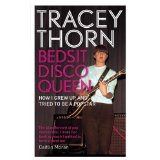 If Donald Fagen’s prose style is easily identifiable, then Tracey Thorn’s is even more so. I’m always impressed when musicians get this right (Peter Hook and Luke Haines also do it particularly well) and, from the first paragraph, this is pitch-perfect ‘Popstar Trace’. The book takes us from the Marine Girls beginnings through the EBTG false starts and eventual success to the beautiful Massive Attack vocals (I’m biased, but you should read about the origins of the modern classic, “Protection” here) and the worldwide Todd Terry-remixed success of “Missing”.
If Donald Fagen’s prose style is easily identifiable, then Tracey Thorn’s is even more so. I’m always impressed when musicians get this right (Peter Hook and Luke Haines also do it particularly well) and, from the first paragraph, this is pitch-perfect ‘Popstar Trace’. The book takes us from the Marine Girls beginnings through the EBTG false starts and eventual success to the beautiful Massive Attack vocals (I’m biased, but you should read about the origins of the modern classic, “Protection” here) and the worldwide Todd Terry-remixed success of “Missing”.
Tracey’s style is perfectly self-deprecatory; you never feel a hint of false modesty and the mentions of famous musicians are always very matter-of-fact, including the story about waiting to pick the kids up from school and being shouted at by George Michael from a Range Rover. This is a wonderful memoir from a genuine pop star.
“Yeah, Yeah, Yeah: The Story of Modern Pop” – Bob Stanley
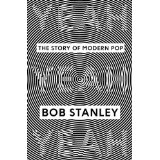 It’s obvious from the outset that this is actually a companion piece to the classic 2012 St Etienne album, “Words and Music”. The album was a voyage through the history of British pop music and the book is an extended verbal remix of the ground covered by the album. What’s equally obvious is that Bob Stanley is both an enthusiast and an insider, which gives him a unique perspective on his subject. He aims to show the links between different styles using not just the music, but also sociological and technological developments. If you’re interested in the history of pop music and you’ve done a bit of research, you might disagree with some of his pronouncements, but it’s a big book and you’ll probably agree with ninety per cent of them.
It’s obvious from the outset that this is actually a companion piece to the classic 2012 St Etienne album, “Words and Music”. The album was a voyage through the history of British pop music and the book is an extended verbal remix of the ground covered by the album. What’s equally obvious is that Bob Stanley is both an enthusiast and an insider, which gives him a unique perspective on his subject. He aims to show the links between different styles using not just the music, but also sociological and technological developments. If you’re interested in the history of pop music and you’ve done a bit of research, you might disagree with some of his pronouncements, but it’s a big book and you’ll probably agree with ninety per cent of them.
The book takes the first NME chart in 1952 as its starting point (which is logical and not controversial) and the end of vinyl as a chart force in 1993 as its end point, when the first Number One singles not to have been released as a 7” single or (a few months later) on vinyl at all topped the charts (if you want to know what they are, you can buy the book ). It’s a slightly more controversial choice but still with a logical basis for someone who grew up in the age of vinyl. The book has an authority derived from Bob Stanley’s experience as a writer and member of a very successful pop group but never slips into the socio-cultural academic approach of, for example, Simon Reynolds. The theme that underpins everything else in this book is that Bob Stanley is still a fan who wants you to come round and listen to his records, and that makes this an unmissable book.
“Here Comes Everybody: The Story of the Pogues” – James Fearnley
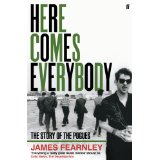 I’ve always been a fan of the “inside story” biography, particularly those that aren’t ghost-written attempts at cultural revisionism. This memoir by James Fearnley is, at times, brutally and crushingly honest about members of The Pogues and he doesn’t spare himself either. The book begins by setting the scene with Shane MacGowan’s departure from the band in 1991 before moving back to Fearnley’s initial meeting with MacGowan at an audition for The Nips in 1980.
I’ve always been a fan of the “inside story” biography, particularly those that aren’t ghost-written attempts at cultural revisionism. This memoir by James Fearnley is, at times, brutally and crushingly honest about members of The Pogues and he doesn’t spare himself either. The book begins by setting the scene with Shane MacGowan’s departure from the band in 1991 before moving back to Fearnley’s initial meeting with MacGowan at an audition for The Nips in 1980.
The book is a (mainly) unsentimental account of the rise and fall of The Pogues from the viewpoint of someone close enough to see everything but with enough distance to retain some objectivity. From the chaotic managerless beginnings through the unpopular but successful stewardship of Frank Murray, the story is underpinned at all times by MacGowan’s unpredictability and seemingly random self-destructive urges. James Fearnley tries very hard to balance the singer’s inexcusable behaviour against the genius of the songs, but it’s up to you if you buy that line; I certainly don’t. My only criticism is that James Fearnley spends a little too much time trying to emphasise the fact that he’s a writer and occasionally introduces unnecessarily florid prose to prove it; putting that aside, it’s still a winner.
“Sounds like London: 100 Years of Black Music in the Capital” – Lloyd Bradley
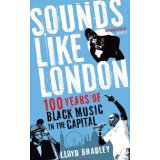 Bear with me for a minute here; this will all make sense presently. Earlier this year I read “How Soon is Now?: The Madmen and the Mavericks who made Independent Music 1975-2005” by Richard King. It’s a very good book and a must for geeks like us, but it attracted a lot of criticism because it didn’t touch on the black music scene. Richard King was even accused, pathetically, of racism in some quarters; you might even have read about it. Personally, I prefer to read authors who write about subjects they understand and that really inspire them; if Richard King didn’t have the expertise, contacts or inspiration to write about the black music scene, then Lloyd Bradley certainly did.
Bear with me for a minute here; this will all make sense presently. Earlier this year I read “How Soon is Now?: The Madmen and the Mavericks who made Independent Music 1975-2005” by Richard King. It’s a very good book and a must for geeks like us, but it attracted a lot of criticism because it didn’t touch on the black music scene. Richard King was even accused, pathetically, of racism in some quarters; you might even have read about it. Personally, I prefer to read authors who write about subjects they understand and that really inspire them; if Richard King didn’t have the expertise, contacts or inspiration to write about the black music scene, then Lloyd Bradley certainly did.
The title is a little misleading; there’s very little about pre-1950s black music, and it also deals with regional English offshoots from the London scene but those aren’t criticisms, just observations. The reason for the comparison with Richard King’s book is that one of Lloyd Bradley’s recurring themes is that black British music has always developed and prospered healthily out of the mainstream when produced and distributed independently.
Once the book reaches the point where Lloyd Bradley can introduce interviews with the players who made black British music happen (the steel pan players, the jazzers, the sound system pioneers, the Britfunk players and the mainstream crossovers Eddy Grant, Janet Kay, Jazzie B and the rest), the narrative really takes off with stories of the sound systems and records being sold out of the back of a car and distributed around the country in the same way. Lloyd Bradley takes us through calypso, ska, reggae, lovers rock, dub, britfunk, 98 bpm, trip hop, jungle, d’n’b, UK garage, dubstep and grime along with a host of short-lived one-way streets with an unassuming and easy authority that is very seductive. If you want an introduction to black British music, this is the book for you.
OK, spoilers alert; I’ve relented. I’ll tell you that the chart-toppers Bob Stanley refers to in 1993 and 1995 respectively are Culture Beat’s “Mr Vain” and Celine Dion’s “Think Twice”, but you should still read the book. Actually you should read all of these books.


